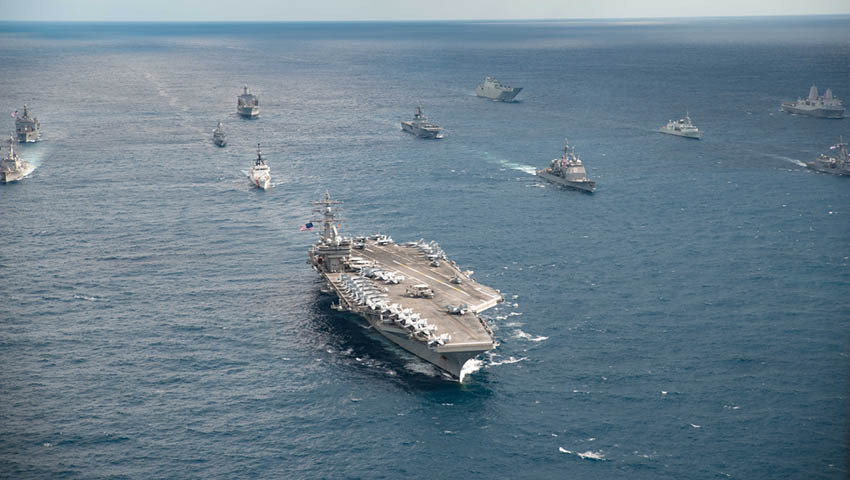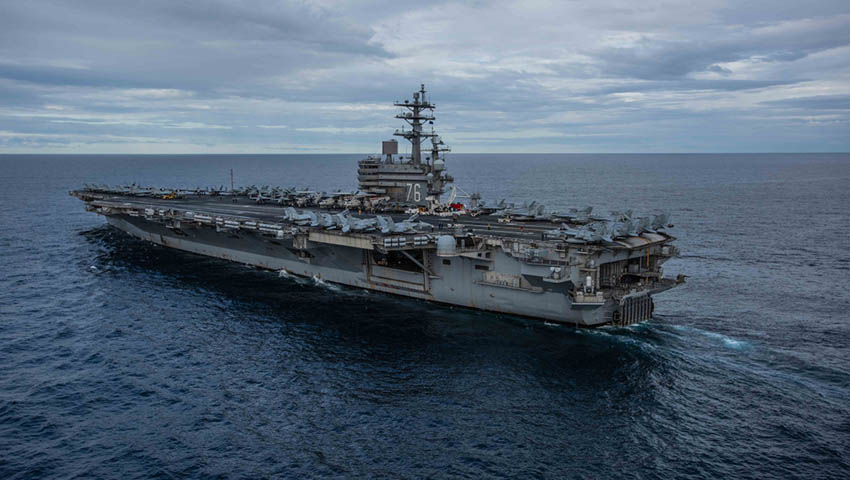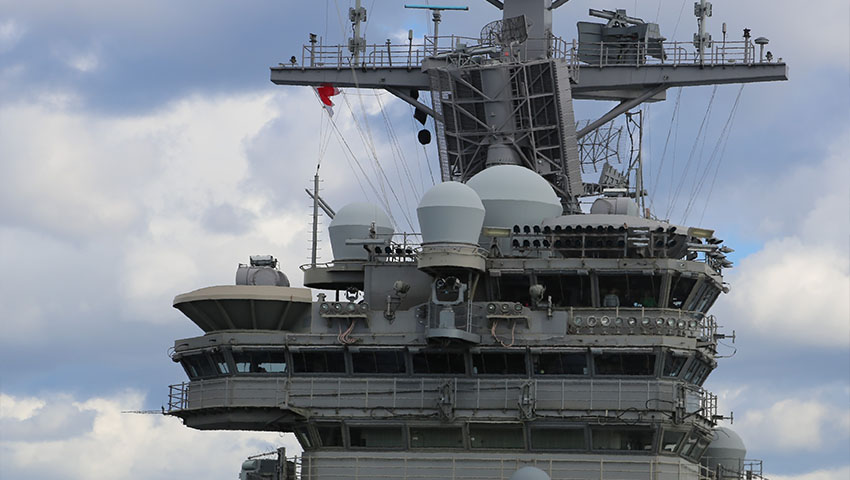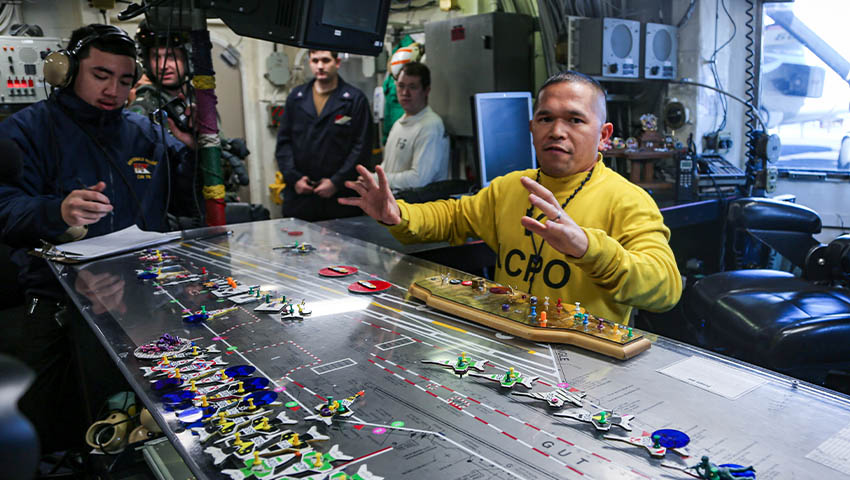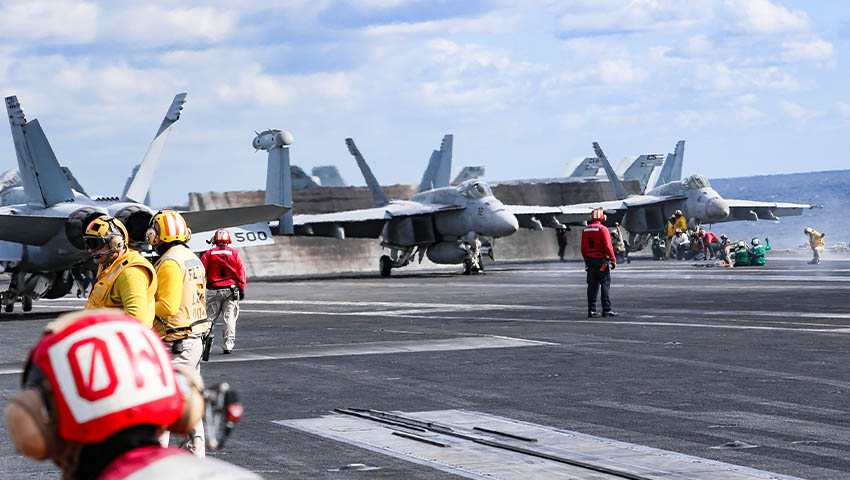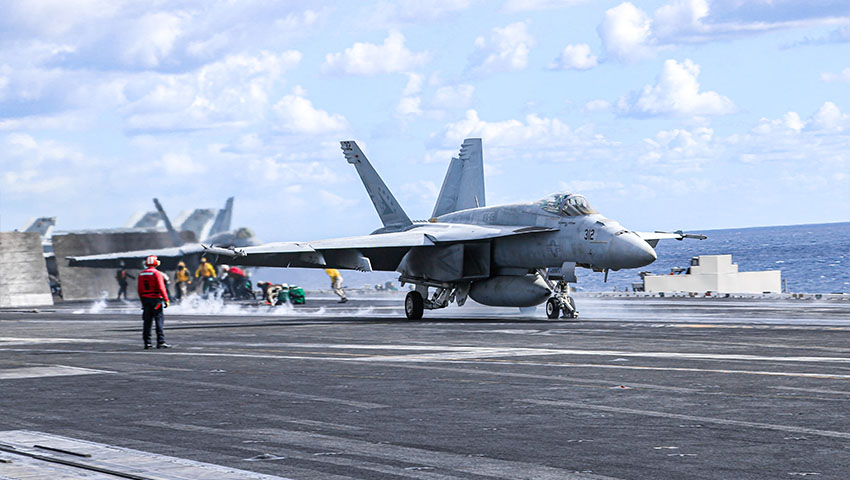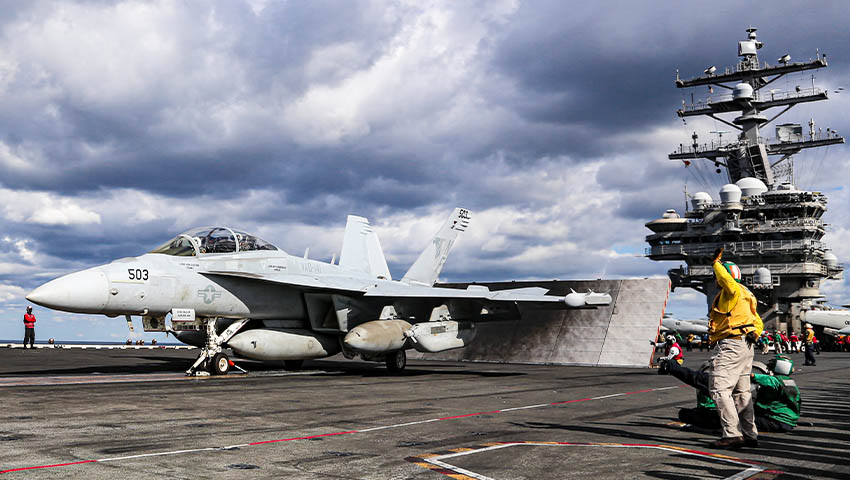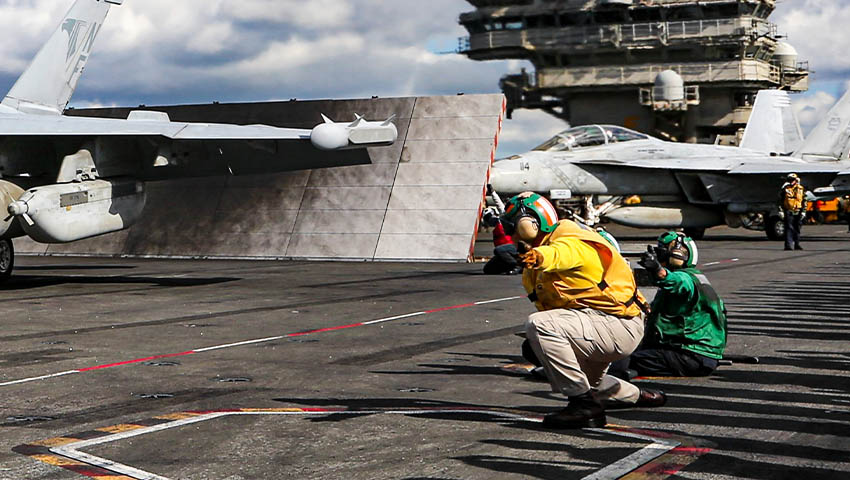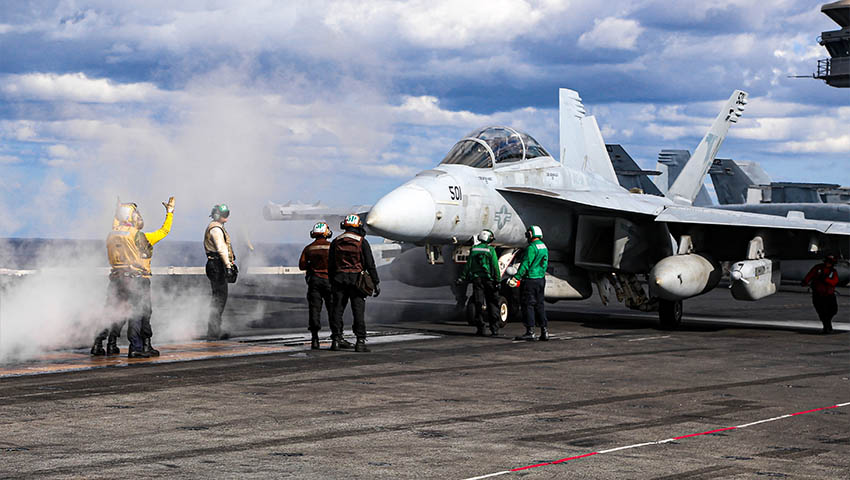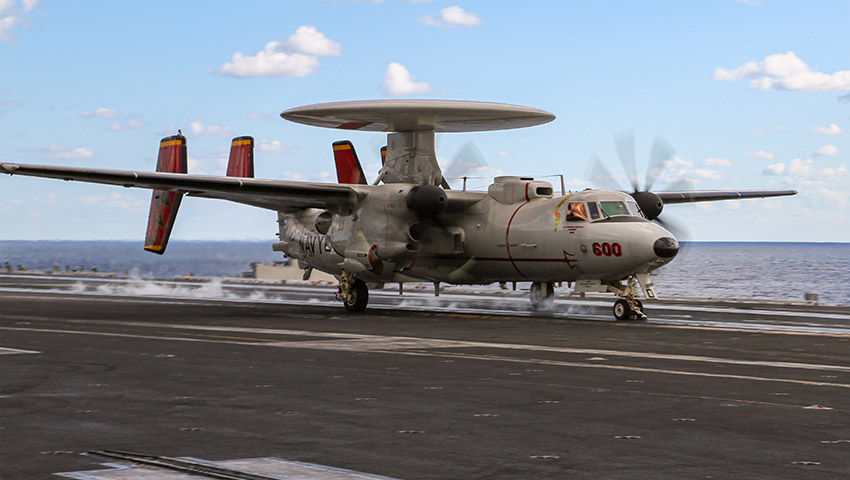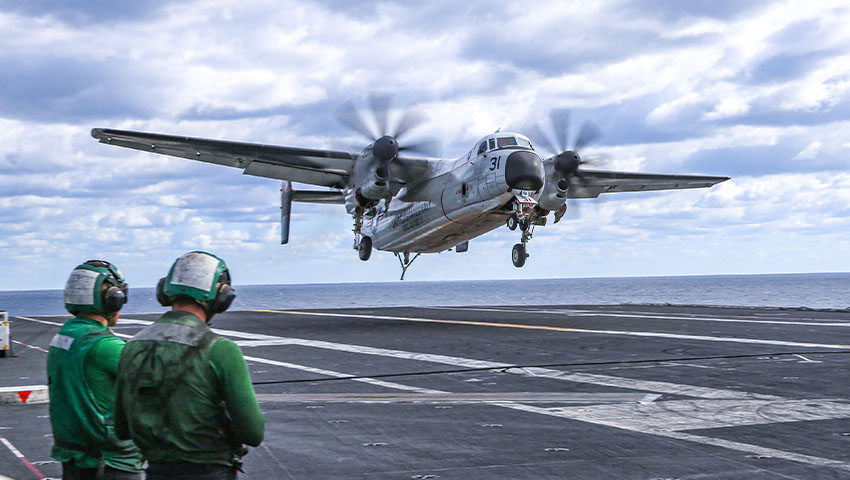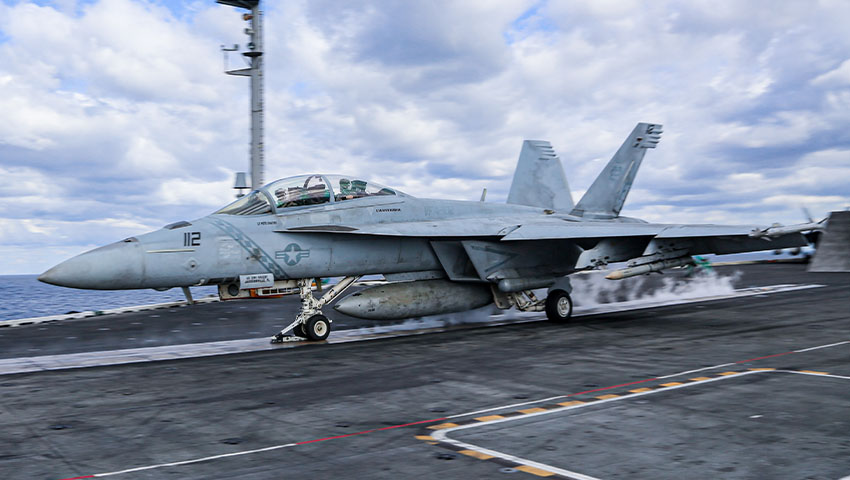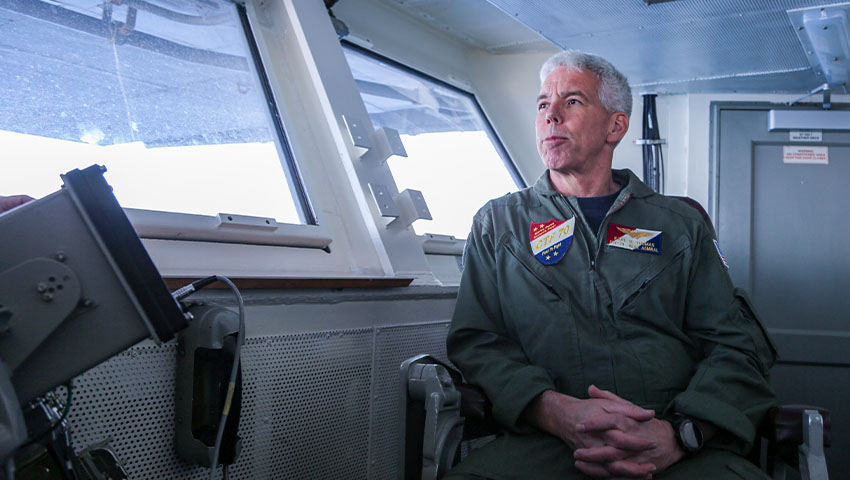image-1 = images/USS-Ronald-Reagan/USS-Ronald-Reagan-3-resize.jpg
title-1 =
description-1 = Laid down in 1998, the USS Ronald Reagan (CVN-79) is the 10th nuclear powered Nimitz Class aircraft carrier in service with the US Navy.
The Reagan entered service in 2004 and conducted air combat operations in the Middle East as part of Operations Enduring Freedom and Iraqi Freedom.
Reagan is pictured here leading the combined US, Australian and Japanese naval task group as part of Exercise Talisman Sabre 2019.
(Source: Department of Defence)
status-1 = 1
image-2 = images/USS-Ronald-Reagan/USS-Ronald-Reagan-2-resize.jpg
title-2 =
description-2 = With a total displacement of over 100,000 tons fully loaded, a length of 333 metres (1,092 feet) and overall beam of 76.8 metres (252 feet), the Ronald Reagan is one of the largest warships afloat.
Powered by two Westinghouse A4W nuclear reactors providing 194 MW to propel the ship at speeds in excess of 30 knots (56+ km/h) the Reagan can rapidly deploy anywhere in the Indo-Pacific.
(Source: Department of Defence)
status-2 = 1
image-3 = images/USS-Ronald-Reagan/USSRegan_Island_Bridge-resize.jpg
title-3 =
description-3 = The USS Ronald Reagan incorporates a range of advanced sensors, command and control and electronic warfare capabilities.
First and foremost is the SPS--48E 3-D air search radar and SPS-49A(V)1 2-D air search radars. Reagan also incorporates 2 SPN-46 air traffic control radars, an SPN-43C air traffic control radar and SPN-41 instrument landing system radar to support combat operations and area-air defence.
(Source: Defence Connect)
status-3 = 1
image-4 = images/USS-Ronald-Reagan/USSRegan_OuijaBoard_SeniorChiefSygaco1-resize.jpg
title-4 =
description-4 = Capable of supporting up to 90 fixed wing and rotary wing aircraft, the Reagan and her sister ships represent the pinnacle of maritime power projection.
Despite its sophisticated suite of sensors and weapons systems, the “Ouija board” of the Reagan, the table used to plot aircraft locations, in flight deck control aboard the aircraft carrier USS Ronald Reagan.
(Source: Defence Connect)
status-4 = 1
image-5 = images/USS-Ronald-Reagan/USSRegan_OuijaBoard_SeniorChiefSygaco1-resize.jpg
title-5 =
description-5 = The Ronald Reagan's carrier air wing (CVW-5) includes a range of aircraft and is based at Naval Air Facility Atsugi, Japan.
CVW-5 is responsible for providing fleet air defence and interdiction, anti-submarine warfare, long-range strike, power projection and air superiority missions in support of the broader Carrier Strike Group.
(Source: Defence Connect)
status-5 = 1
image-6 = images/USS-Ronald-Reagan/USSRegan_F-18SuperHornet_Launch5-resize.jpg
title-6 =
description-6 = CVW-5 operates four squadrons of Boeing F-18 E/F Super Hornet aircraft – similar to those operated by the Royal Australian Air Force.
The four squadrons are VFA-27 (Royal Maces), VFA-102 (Diamondbacks), VFA-115 (Eagles) and VFA-195 (Dambusters).
The four catapults of the Ronald Reagan enable the carrier to simultaneously launch four fully laden combat aircraft at a time, while recovering aircraft with the arrestor wires.
(Source: Defence Connect)
status-6 = 1
image-7 = images/USS-Ronald-Reagan/USSRegan_F-18SuperHornet_Launch6-resize.jpg
title-7 =
description-7 = Like the Classic Hornets, the Super Hornets undertake a variety of mission profiles, including air interception, air combat, close air support and interdiction operations.
The Super Hornet has a top speed of Mach 1.6 (1,960km/h) with a range of 2,700 kilometres.
(Source: Defence Connect)
status-7 = 1
image-8 = images/USS-Ronald-Reagan/USSRegan_F-18SuperHornet_Launchprep3-resize.jpg
title-8 =
description-8 = CVW-5 also operates a detachment of Boeing E/A-18G Growler electronic attack aircraft as part of VAQ-141 (Shadowhawks).
The E/A-18G Growler is a specialised electronic attack variant of the Super Hornet.
Growlers have a top speed of Mach 1.6 (1,960km/h) and a range of 1,570 kilometres when fully armed with external fuel tanks.
(Source: Defence Connect)
status-8 = 1
image-9 = images/USS-Ronald-Reagan/USSRegan_Shooter4-resize.jpg
title-9 =
description-9 = Home to over 5,000 sailors and marines, the Reagan is a floating city where each individual plays a critical role in the combat effectiveness of the aircraft carrier.
Reagan has a total ships company of 3,532 and an air wing strength of 2,480.
The “shooter” pictured here is essential for supporting combat operations and is responsible for the final go-ahead for launching an aircraft.
(Source: Defence Connect)
status-9 = 1
image-10 = images/USS-Ronald-Reagan/USSRegan_F-18SuperHornet_Launchprep5-resize.jpg
title-10 =
description-10 = Australia’s fleet of 11 (formally 12) are built to the same standard as the US Navy’s fleet of Growler aircraft.
The E/A-18G replaces the Northrop Grumman designed and built EA-6B Prowlers.
Growlers provide a common platform for both the ADF and US Navy promoting greater levels of interoperability and distributed lethality throughout the multi-domain battlespace.
(Source: Defence Connect)
status-10 = 1
image-11 = images/USS-Ronald-Reagan/USSRegan_E-2Hawkeye_Launch-resize.jpg
title-11 =
description-11 = CVW-5 operates a small detachment of the Northrop Grumman E-2D Advanced Hawkeye as part of VAW-125 (Tiger Tails).
The E-2D is the fourth version of the Hawkeye platform and incorporates a range of capability improvements over the original platform, including advanced airborne command and control sensors, integrated avionics and advanced communications.
Variants of the E-2 have been in production since 1960, making the aircraft the longest continuously produced carrier-borne aircraft in history.
(Source: Defence Connect)
status-11 = 1
image-12 = images/USS-Ronald-Reagan/USSRegan_E-2Hawkeye_Launch-resize.jpg
title-12 =
description-12 = The E-2D plays a similar role to that of traditional airborne early warning, command and control systems like the RAAF’s E-7A Wedgetails.
Advanced Hawkeye and the Hawkeye family are in service with the Armed Forces of Egypt, France, Israel, Japan, Mexico, Singapore and Taiwan.
Additionally, the E-2D features an entirely new avionics suite including the new AN/APY-9 radar, radio suite, mission computer, integrated satellite communications, flight management system, improved T56-A-427A engines, a glass cockpit and later changes should enable aerial refueling by 2020.
(Source: Defence Connect)
status-12 = 1
image-13 = images/USS-Ronald-Reagan/USSRegan_C2Greyhound_Landing-resize.jpg
title-13 =
description-13 = CVW-5 incorporates a small detachment of C-2A Greyhounds as part of Fleet Logistics Support Squadron 30 - Detachment 5 (VRC-30).
Referred to as the Providers, Reagan’s Greyhounds fulfill the US Navy’s carrier-onboard-delivery aircraft, providing critical logistics support role.
The C-2A can deliver a payload of up to 4.5 tonnes. The cabin can readily accommodate cargo, passengers or both.
(Source: Defence Connect)
status-13 = 1
image-14 = images/TS12/3.jpg
title-14 =
description-14 = The initial Greyhound aircraft were overhauled in 1973. In 1984, more C-2As were ordered under designation Reprocured C-2A or C-2A(R).
In 2010, all C-2A(R) aircraft received updated propellers (from four to eight blades) and navigational updates (glass cockpit).
In February 2015, the Navy’s FY 2016 budget confirmed the V-22’s selection for the COD mission, replacing the C-2A. The Navy model of the aircraft is called the CMV-22B; 44 will be purchased and deliveries will start in 2020.
The C-2 was originally planned to be retired in 2027, but this was accelerated to 2024.
(Source: Defence Connect)
status-14 = 1
image-15 = images/USS-Ronald-Reagan/USSRegan_F-18SuperHornet_Launch10-resize.jpg
title-15 =
description-15 = The angled flight decks of the carriers use a CATOBAR arrangement to operate aircraft, with steam catapults and arrestor wires for launch and recovery.
As well as speeding up flight deck operations, this allows for a much wider variety of aircraft than with the STOVL arrangement used on smaller carriers like large-deck amphibious warfare ships.
The C-13-2 catapults installed on the Reagan have a maximum launch rating of 36 tons at 140 knots.
These steam-powered catapults run 99 metres in length and are located at the bow and midsection of the carrier’s flight deck.
(Source: Defence Connect)
status-15 = 1
image-16 = images/USS-Ronald-Reagan/USSRegan_Rear-Admiral-Karl-O-Thomas-Commander-Task-Force-70-resize.jpg
title-16 =
description-16 = Rear Admiral Karl O. Thomas on the bridge of the USS Ronald Reagan. RADM Thomas is the commander of Carrier Strike Group 5.
RADM Thomas earned a Master of Science in Information Technology from Naval Postgraduate School and received initial training in the airborne early warning aircraft, E-2C Hawkeye, Thomas served in the Carrier Airborne Early Warning Squadron (VAW) 114 where he made two deployments onboard USS Carl Vinson (CVN 70), as well as two counter-narcotic detachments to Panama. RADM Thomas also served as navigator onboard USS New Orleans (LPH 11) and USS Essex (LHD 2). He served an aviation department head tour with VAW-117, and once again deployed on the Carl Vinson in 1999 participating in Operation Desert Fox.
Shore duty assignments include VAW-110 as a fleet replacement instructor; flag aide for both Commander, Fighter Airborne Early Warning Wing Pacific and director of Naval Reactors. He served in the Office of the Under Secretary of Defense for Acquisition, Technology and Logistics (OUSD AT&L) (Unmanned Warfare) and coordinated the OUSD AT&L Unmanned Air Systems Task Force. He served as the executive assistant to the Director, Air Warfare (N98), and most recently served as director, 21st Century Sailor Office (N17).
RADM Thomas assumed the duties of Commander, Task Force SEVEN ZERO/Commander, Carrier Strike Group FIVE on 18 July 2018.
(Source: Defence Connect)
status-16 = 1
image-17 =
title-17 =
description-17 =
status-17 =
image-18 =
title-18 =
description-18 =
status-18 =
image-19 =
title-19 =
description-19 =
status-19 =
image-20 =
title-20 =
description-20 =
status-20 = 0
Photo Essay: 100,000 tons of diplomacy – the might of the USS Ronald Reagan
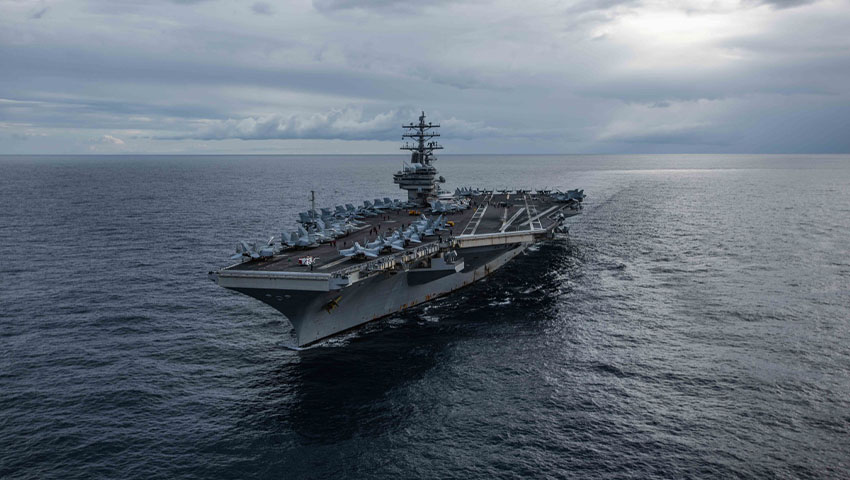
Click to launch gallery
Scroll to read and see more
The USS Ronald Reagan (CVN-76) transits the Coral Sea as part of Exercise Talisman Sabre 2019 (Source Dept of Defence)
There is no more potent symbol of American military might and presence than a US Navy aircraft carrier – the USS Ronald Reagan is the tip of the spear in the Pacific, being forward-deployed to Yokosuka, Japan, and is a key catalyst for promoting interoperability for key allies, including Australia.
There is no more potent symbol of American military might and presence than a US Navy aircraft carrier – the USS Ronald Reagan is the tip of the spear in the Pacific, being forward-deployed to Yokosuka, Japan, and is a key catalyst for promoting interoperability for key allies, including Australia.
You’re out of free articles for this month
To continue reading the rest of this article, please log in.
Create free account to get unlimited news articles and more!
Today, strategic sea lines of communication support over 90 per cent of global trade, a result of the cost-effective and reliable nature of sea transport. Indo-Pacific Asia is at the epicentre of the global maritime trade, with about US$5 trillion worth of trade flowing through the South China Sea and the strategic waterways and choke points of south-east Asia annually.
The Indian Ocean and its critical global sea lines of communication are responsible for more than 80 per cent of the world’s seaborne trade in critical energy supplies, namely oil and natural gas, which serve as the lifeblood of any advanced economy.
Aircraft carriers emerged from the Second World War as the pinnacle of maritime prestige and power projection. However, unlike their predecessor, the battleship, aircraft carriers are in themselves relatively benign actors, relying heavily on their attached carrier air-wings and supporting escort fleets of cruisers, destroyers and submarines to screen them from hostile action and project power throughout their area of operations.
Carrier air wings and long-range strike
1
As the second-largest air force in the world, the US Navy sets the standard for the carrier air wing, a concept that has been perfected throughout the Cold War and into the new millennium to maximise the long-range strike, high-speed, intelligence, surveillance and reconnaissance and integrated multi-domain command and control systems that have guaranteed US and allied maritime dominance since the collapse of the Soviet Union.
While early concepts of the carrier air wing evolved throughout the pitched carrier battles that raged through the Pacific, the advent of Soviet nuclear-powered hunter-killer submarines and advanced long-range, supersonic bombers armed with advanced, sea-skimming anti-ship cruise missiles resulted in a shake-up in the structure of the carrier air wing.
Meanwhile, the shift towards asymmetric, counter-insurgency operations in Afghanistan, Iraq and Syria gave rise to long-range, strike and interdiction focused carrier air wings. As the world’s pre-eminent carrier power, the US sets the standard for current carrier air wings, which are made up of a a range of potent naval aviation assets, including:
- Strike Fighter (VFA) Squadrons: Four squadrons with 12 F-18E/F Super Hornets each, or 10 F-18C Hornets (over 40 strike fighters in total). In two air wings one of the F-18C Hornet squadrons is an embarked US Marine Corps Fighter Attack (VMFA) Squadron – as the production of the C variant of the fifth-generation F-35 gathers pace the older F-18C squadrons will be replaced by the F-35C.
- Electronic Attack Squadron (VAQ): A single squadron made up of five EA-18G Growler electronic attack aircraft – an advanced variant of the F-18E/F Super Hornet airframe.
- Carrier Airborne Early Warning (VAW) Squadron: A single squadron made up of four E-2C Hawkeye or five E-2D Advanced Hawkeye airborne early warning, command and control aircraft to provide an integrated, carrier-borne AWACS capability to co-ordinate the air interdiction, strike and power projection capability of the carrier air wing.
- Helicopter Sea Combat (HSC) Squadron: A single squadron of eight MH-60S Seahawk helicopters providing a range of inter-fleet logistics support, anti-submarine and personnel transfer capabilities.
- Helicopter Maritime Strike (HSM) Squadron: A single squadron of 11 MH-60R Romeo Seahawk helicopters, three to five of which are typically based in detachments onboard the supporting screen ships in the carrier strike group to provide over-the-horizon maritime strike, intelligence, surveillance and reconnaissance and anti-submarine capabilities.
- Fleet Logistics Support (VRC) Squadron Detachment: A specialised detachment of two C-2A Greyhounds providing long-range fleet logistics support – set to be replaced by a specialised variant of the Boeing V-22 Osprey tiltrotor aircraft to fulfill the long-range vertical replenishment role.
The USS Ronald Reagan (CVN-79) is named after the 40th president of the United States, Ronald W Reagan (term 1981-1989), and is the flagship of not only the US Navy, but is also the flagship of the only forward-deployed carrier strike group, Carrier Strike Group 5 based out of Yokosuka, Japan – the Reagan's motto is “Peace through strength” echoing President Reagan’s focus on military strength to overcome the threat of the Soviet Union.
Both fixed-wing naval aviation capabilities are key force multipliers reshaping the region. The growing prevalence of fixed-wing naval aviation forces, particularly, serves to alter the strategic calculus and balance of power. Let us know your thoughts in the comments section below, or get in touch with This email address is being protected from spambots. You need JavaScript enabled to view it. or This email address is being protected from spambots. You need JavaScript enabled to view it..
Steve has an extensive career across government, defence industry and advocacy, having previously worked for cabinet ministers at both Federal and State levels.

 Login
Login





